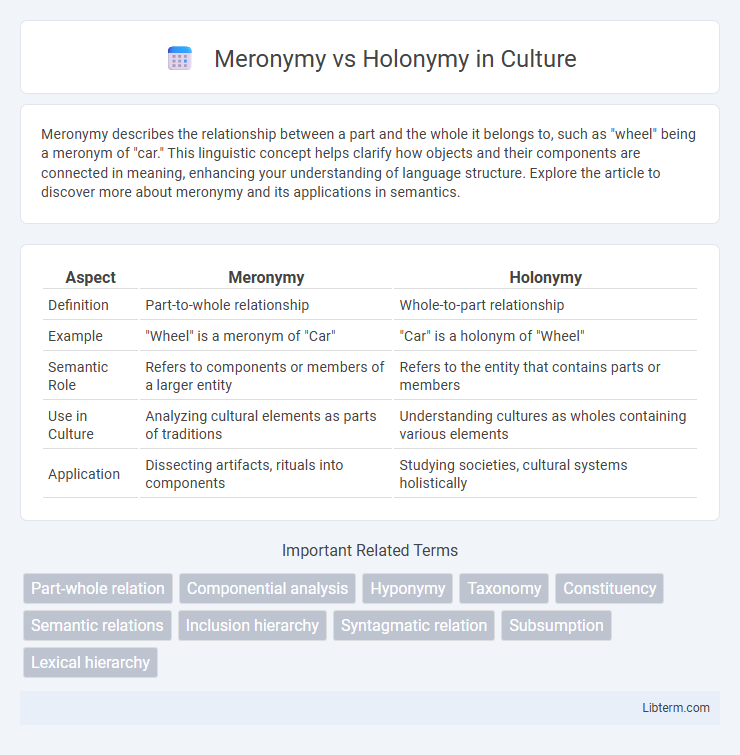Meronymy describes the relationship between a part and the whole it belongs to, such as "wheel" being a meronym of "car." This linguistic concept helps clarify how objects and their components are connected in meaning, enhancing your understanding of language structure. Explore the article to discover more about meronymy and its applications in semantics.
Table of Comparison
| Aspect | Meronymy | Holonymy |
|---|---|---|
| Definition | Part-to-whole relationship | Whole-to-part relationship |
| Example | "Wheel" is a meronym of "Car" | "Car" is a holonym of "Wheel" |
| Semantic Role | Refers to components or members of a larger entity | Refers to the entity that contains parts or members |
| Use in Culture | Analyzing cultural elements as parts of traditions | Understanding cultures as wholes containing various elements |
| Application | Dissecting artifacts, rituals into components | Studying societies, cultural systems holistically |
Introduction to Meronymy and Holonymy
Meronymy and holonymy describe part-whole relationships in linguistics where meronymy refers to a word representing a part of something, such as "wheel" being a meronym of "car." Holonymy represents the whole entity that includes parts, with "car" acting as a holonym for "wheel." Understanding these relationships enhances semantic networks and improves natural language processing applications by clarifying how components relate to their larger entities.
Defining Meronymy: Meaning and Examples
Meronymy is a semantic relationship where a term denotes a part or component of something larger, such as "wheel" in relation to "car." It contrasts with holonymy, where the focus is on the whole entity, like "car" being the holonym of "wheel." Examples of meronymy include "leaf" as part of a "tree" and "finger" as part of a "hand," highlighting hierarchical part-to-whole connections in language.
Defining Holonymy: Meaning and Examples
Holonymy is a semantic relationship where a term denotes a whole that includes other terms as its parts, contrasting with meronymy, which describes the part-to-whole relationship from the perspective of the components. For example, "tree" is a holonym of "branch," "leaf," and "trunk," because these parts collectively constitute the whole tree. Understanding holonymy is essential in fields like linguistics, cognitive science, and natural language processing for analyzing hierarchical structures and part-whole associations in language.
Key Differences Between Meronymy and Holonymy
Meronymy refers to the semantic relationship where a term denotes a part of something, such as "wheel" being a meronym of "car." Holonymy is the inverse relationship where a term represents the whole that includes the parts, like "car" being a holonym of "wheel." Key differences include that meronymy focuses on part-to-whole connections from the perspective of components, while holonymy addresses whole-to-part associations emphasizing the larger entity.
Linguistic Functions of Meronymy
Meronymy represents the semantic relationship where a term denotes a part of something, crucial for understanding compositional structure in language and cognition. It facilitates detailed descriptions by linking parts to wholes, enhancing information retrieval and natural language processing tasks. In contrast, holonymy denotes the whole that contains the part, but meronymy specifically supports linguistic functions like specificity in discourse and efficient vocabulary organization.
Linguistic Functions of Holonymy
Holonymy functions as a crucial linguistic relationship where a holonym denotes the whole and its meronyms represent the parts, aiding semantic clarity in language processing. It helps in structure comprehension, enabling better text analysis and natural language understanding by linking components back to their wholes. This relationship enhances lexical databases and ontologies by organizing vocabulary into hierarchies that reflect real-world part-whole associations.
Meronymy and Holonymy in English Language
Meronymy in the English language refers to the semantic relationship where a term denotes a part of something, such as "wheel" being a meronym of "car." Holonymy represents the inverse relationship, where a term stands for the whole entity, like "car" serving as a holonym for "wheel." Understanding meronymy and holonymy enhances lexical semantics by clarifying part-to-whole and whole-to-part associations in English vocabulary.
Importance in Semantic Analysis
Meronymy and holonymy play crucial roles in semantic analysis by defining part-whole relationships between concepts, enabling more accurate text understanding and information retrieval. Recognizing meronyms (parts) and holonyms (wholes) enhances natural language processing tasks such as word sense disambiguation, knowledge representation, and ontology development. These relationships support hierarchical reasoning, improving the extraction of meaningful connections within large datasets and knowledge graphs.
Common Applications in Natural Language Processing
Meronymy and holonymy play crucial roles in Natural Language Processing by enabling machines to understand part-whole relationships in text, which improves tasks like semantic search, information extraction, and knowledge graph construction. Meronymy identifies when one term denotes a part of something (e.g., 'wheel' as part of 'car'), while holonymy refers to the whole entity that includes the parts (e.g., 'car' as a whole containing 'wheel'). These relationships help enhance word sense disambiguation, text summarization, and contextual word embeddings by providing deeper semantic context.
Conclusion: Understanding Semantic Relationships
Meronymy and holonymy represent fundamental semantic relationships that describe part-whole connections between concepts, where meronymy indicates a part of a whole and holonymy signifies the whole to which parts belong. These relationships enhance natural language understanding by enabling more precise information retrieval, text analysis, and knowledge representation in linguistics and computational language models. Mastery of meronymy and holonymy supports improved semantic reasoning, facilitating applications such as ontology development and automated semantic annotation.
Meronymy Infographic

 libterm.com
libterm.com